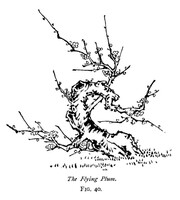The Japanese Plum-tree is even more prolific in varieties, but under the native term for Plum (Ume) are included one or two kinds of the Jasminum and other species. They may be enumerated as follows:�Prunus mume (Ume), Prunus japonica (Niwa-ume), Prunus mume, fl. coceinea (Kobai), Prunus tomentosa (Yusura-ume), Prunus mume, var. pleiocarpas (Mizaron-ume), Jasminum sieboldianum (Obai), Jasminum floridum (Riu-kiu-obai), Potentilla fructicosa (Kin-robai), Raphiolepis japonica (Sharin-ume). Other distinguishing names for garden varieties are:� Shichi-gwatsu-ume, or July Plum; Tobi-ume, or Flying Plum (see Fig. 40); Shidare-ume, or Drooping Plum; No-ume, or Wild Plum; Hai-ume, or Crawling Plum; Tomeko-ume, or Small Blossom Plum; Gin-ume, or Silver Plum; Ogawa-ume, or River Plum; Chigo-ume, or Tiny Blossom Plum; Kikkwa-bai, or Chrysanthemum Blossom Plum; Yama-ume, or Mountain Plum; Asagi-ume, or Pale Blue Plum; Mochi-ume, or Cluster Blossom Plum; Fuyu-ume, or Winter Plum; Saigio-ume, or Saigo Plum; Bungo-ume, or Bungo**** Plum; Miyagi-ume, or Miyagi**** Plum; Suzunari-ume, or Rich Cluster Plum; Yaye-riokugaku-bai, or Double-emerald-blossom Plum; Hanazaron-ume, or Ephemeral-blossom Plum; Suo-kobai, or Deep Red Plum; Kan-kobai, of Winter Red Plum; Rioku-gaku-bai or Emerald-blossom Plum; Shidare-midori-ume, or Drooping-emeraled Plum; Mikaiko-ume, or Light Red Plum; Oshuku-bai, or Nightingale-dwelling Plum; Yokihi-ume, or Lovely White Plum; Toji-bai, or Chinese Plum; Naniwa-ume, or Naniwa**** Plum; Eizan-kabai, or Eizan**** Red Plum; Hassaku-bai, or Eighth Month Plum; Miuki-ume, or Fruit-growing Plum; Ogon-ume, or Golden Plum; Chirimen-kobai, or Crape-like Red Plum; Fudan-ume, or Common Plum; Goshiki-ume, or Prismatic-coloured Plum; Futairo-ume, or Double-coloured Plum; Kuro-ume, or Dark-coloured Plum; Haya-haku-bai, or Early White Plum; and Yaye-kobai, or Double Red Plum. Other blossoming fruit trees are:�Prunus armenica (Anzu), Prunus communis (Amendo), Prunus macrophylla (Biran), Prunus spinulosa (Rinboku), Prunus triflora (Sumomo), Jasminum grandiflorum (Sokei), Pyrus japonica (Boke, Haruboke, Shiroboke, and Koboke), Pyrus japonica, var. pygm�a (Kusa-boke), Pyrus malus (Ringo), Pyrus cydonia (Marumero), Pyrus ussuriensis (Nashi), Pyrus spectabilis (Kaido, Yama-kaido, and Shidare-kaido), Cyrus chinensis (Kwarin), Punica granatum (Zakuro), Photinia japonica (Biwa), Meliosma pungens (Yama-biwa), Diospyrus kaki (Kaki), and Zizyphus vulgaris (Natsume). (* Taizanji and Jizenkoji are names of noted temple groves.) (** Yokihi, the name of a beautiful Chinese Princess, is often applied to blossoms of special whiteness and loveliness.) (*** Kuruma-gaeshi�means "to send back the carriage" and refers to the gorgeously trapped bullock waggons in which the ladies of the Court were driven to view the flowers. The idea conveyed in its present context is that the beauty of the blossoms, requires a long day for the full enjoyment of them, and that carriages should be sent back.) (**** Bungo and Miyagi are names of provinces, and Naniwa and Eizan names of places in Japan.)

